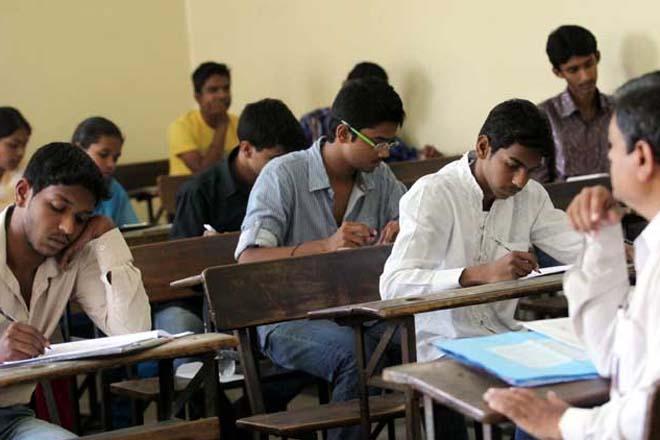BJP’s Record on Education Runs Afoul of Its Own Manifesto

In their short social life and even shorter life in public memory, election manifestos perform a variety of tasks. Attempting to strike different notes at once, they sway between grandiose promise-making, novelty and a teaser of all good things that would unfurl post-elections. Intentions, promises and possible actions form common elements of the script that covers broad issues including foreign relations, defence and social security. While revealing an overall direction, focus and emphasis, manifestos also do the work of re-framing, re-naming and signalling.
Given its crucial role in not just generating human capital, but its relevance to a number of social and cultural processes, it is instructive to turn to education and its place in the manifestos of 2014. All major political parties gave considerable amount of space to education along with other issues of social welfare such as health, food and employment. Focus on quality, entrepreneurship and welcoming of the public-private partnerships are some of the popular ways in which educational issues have been discussed in manifestos across party lines.
Here, we pay attention to the 2014 election manifesto of the BJP – in order to understand what was promised and what was delivered.
Intention: education for national integration
The document begins with a plea to restore India’s inner vitality, recognise her strides in science and other branches of knowledge long before the Europeans, and the need to develop a ‘civilisational consciousness’. Education, of course, plays a key role in the mammoth project of the restoration of past glory. Stating that education is the most powerful tool for nation-building and development, the manifesto articulates the role of education in “national integration, social cohesion, religious amity, national identity and patriotism”.
The manifesto abstains from using the word secularism, opting instead for religious amity. Interestingly, the term ‘social justice’ (samajik nyay) is reintroduced with a conjoined term ‘social harmony’ (samajik samarasata). This is primarily done in order to attempt a re-working of the discourse of reservations – from social justice to empowerment and enabling. “Instead of pursuing identity politics and tokenisms, we will focus on empowering the deprived sections of society. Steps will be taken to create an enabling ecosystem of equal opportunity – for education, health and livelihood.” These promises, however, did not amount to much after 2014 as the last four years have witnessed remarkable cuts in SC/ST sub plans, ultimately affecting access and opportunity for the marginalised.
Seeking to review and revise the education system, the BJP’s manifesto lists a number of changes and reforms. We discuss four major proposals considered for restructuring
Where is the National Education Policy?
The BJP had planned to set up a National Commission on Education that would submit a report on the state of education with necessary reforms. The report was to be the basis for the government to draft and implement the National Education Policy (NEP). Given that reforms in education in India have occurred without a comprehensive policy for more than two decades, this was a much-needed goal. The Ministry of Human Resource Development (MHRD) took more than 18 months to form the committee that submitted the report in May 2016.
As the first committee was dissolved following serious debates surrounding the contents of the report, the second committee was appointed in June 2017. Notwithstanding the record number of consultations and procedures for online feedback, the committee report and policy draft are awaited. While this is a significant shortcoming, there are a number of associated reasons that are more serious. Without waiting for the NEP to release, the government introduced a flurry of changes: reversal of no-detention policy in schools by amending the RTE Act, merging of the Sarva Shiksha Abhiyan (SSA) and Rashtriya Madhyamik Shiksha Abhiyan (RMSA); delay and slashing of funds for the SSA; introduction of learning outcomes in early grades, and slashing of funds for centres researching social exclusion – to name a few.
Van Bandhu Kalyan Yojana (VBKY): whose welfare?
Overseen by Tribal Development Authority, the national scheme for the welfare of Adivasi communities promised to focus on the following major tasks: setting up an entire education network for tribals; upgrading housing, water and health facilities; electrification of tribal hamlets; and provision of all-weather roads. The scheme also involved establishing a ‘national centre for tribal research and culture’.
As far as the first agenda of establishing an educational network for Adivasis is concerned, no significant achievements have been made. Several forms of educational exclusion continue to be part of the schooling experience for Adivasi children. In 2016, a number of reports covered the deaths of schoolchildren in ashram schools of Maharashtra. Deficits in physical safety, nutrition and basic health have been highlighted as factors responsible for the conditions of schools.
The review of VBKY shows a drastic drop in funding – from Rs 200 crores in 2015-16 to Rs 1 crore in 2017-18. The national centre for tribal research has not been set up either!
Beti Bachao Beti Padhao (BBBP): A heady mix of populism and patriarchy
The 2014 manifesto sees Beti Bachao Beti Padhao (BBBP) as a national campaign to save and educate girls. Without much elaboration, BBBP is introduced as part of a commitment to women’s welfare, along with a number of proposed areas of intervention including health, skill training and safety. BBBP became a flagship scheme that would address the declining child sex ratio (CSR) and work towards an increase in the enrolment of girls in schools.
Administered jointly by the Ministry of Women and Child Development (MWCD), the MHRD and the Ministry of Health and Family Welfare (MHFW), the scheme focused on 100 districts at first and was subsequently expanded. The scheme involves local-level interventions along with nationwide communication and awareness-building. While the scheme has captured the popular imagination, reports by the Comptroller and Auditor General (CAG) suggest inefficient allocation and disbursement of funds, lacunae in local interventions and, more importantly, disproportionately more expenditure on matters of communication over those of interventions, including those related to education.
Dismantling institutions 101 – the UGC
As part of its proposed interventions in higher education revolving around global ranking and deregulation, the BJP manifesto sought to restructure the University Grants Commission (UGC) and bring in the higher education commission.
In 2017, the government took two steps in the direction of displacing the UGC. First, a single statutory body in the form of the Higher Education Empowerment Regulation Agency (HEERA) was formed. HEERA was to simplify regulation by subsuming the functions of the UGC and the All India Council for Technical Education (AICTE). Second, the government floated the Higher Education Commission of India (HECI) bill, repealing the University Grants Commission Act, 1956.
While the draft bill drew criticism for a number of issues, it is important to take note of the following: the move to restructure the UGC was propelled without waiting for the NEP to be ready. The haste with which the HECI bill was introduced only showed the recklessness with which existing institutions are being dismantled. Further, the draft was given ten days to receive feedback from the public and, after much criticism, the time-frame for seeking feedback was extended.
In parallel developments, the government set up the Higher Education Financial Authority (HEFA) – a joint venture between the MHRD and Canara Bank – to provide loans to academic institutions for their infrastructural projects. This move clearly indicates a transition of financial aid and grants in higher education towards loans. Cutting institutional budgets on the one hand, and enabling entry of non-bank financial agencies and practices of institutional loans on the other, open up serious questions that need attention. Institutional autonomy, repayment plans, costs of accessing higher education and quality are some of the issues that are closely connected to the changes that may soon be part of the story of institutions of higher education.
Finally, the manifesto declared that public spending on education will be increased up to 6% of the GDP. The government has spent less than 3% in the last five years. Weakening institutions, making way for commercialisation of higher education and slashing support for educational welfare are some of the obvious examples of the short-sightedness herein. Notwithstanding the rhetoric, the present government’s report card on education has more misses than hits.
[“source=thewire”]




